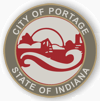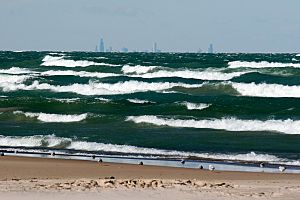Portage, Indiana facts for kids
Quick facts for kids
Portage, Indiana
|
||
|---|---|---|

Downtown Portage in 2016
|
||
|
||
| Nickname(s):
The Port City/The Port of Opportunity
|
||

Location of Portage in Porter County, Indiana.
|
||
| Country | United States | |
| State | Indiana | |
| County | Porter | |
| Township | Portage | |
| Government | ||
| • Type | Strong Mayor-Council | |
| Area | ||
| • Total | 27.65 sq mi (71.60 km2) | |
| • Land | 25.55 sq mi (66.17 km2) | |
| • Water | 2.10 sq mi (5.43 km2) | |
| Elevation | 633 ft (193 m) | |
| Population
(2020)
|
||
| • Total | 37,926 | |
| • Density | 1,484.38/sq mi (573.13/km2) | |
| Time zone | UTC−6 (CST) | |
| • Summer (DST) | UTC−5 (CDT) | |
| ZIP code |
46368
|
|
| Area code(s) | 219 | |
| FIPS code | 18-61092 | |
| GNIS feature ID | 2396254 | |
| Website | http://www.ci.portage.in.us | |
| Historical population | |||
|---|---|---|---|
| Census | Pop. | %± | |
| 1950 | 2,116 | — | |
| 1960 | 11,822 | 458.7% | |
| 1970 | 19,127 | 61.8% | |
| 1980 | 27,409 | 43.3% | |
| 1990 | 29,060 | 6.0% | |
| 2000 | 33,496 | 15.3% | |
| 2010 | 36,828 | 9.9% | |
| 2020 | 37,926 | 3.0% | |
| Source: US Census Bureau | |||
Portage (pronounced POR-tij) is a city in Portage Township, Porter County, in the U.S. state of Indiana. It's located right on the border with Lake County, Indiana. In 2020, about 37,926 people lived here. Portage is the biggest city in Porter County and the third largest in the Northwest Indiana area.
Contents
A Look Back: Portage's Past
Early Times: Before Europeans Arrived
Long ago, before Europeans settled here, Native American tribes lived in Northwest Indiana. Some ancient people, called Mound Builders, left a large mound in the area now known as McCool. Sadly, this mound was destroyed in the early 1900s. After the Mound Builders, the Wea tribe lived here. Later, the Potawatomi tribe moved into the area, causing the Wea to move south.
First Explorers and Settlers
Some famous explorers like Jacques Marquette and Louis Jolliet might have explored this area. A Potawatomi chief named Leopold Pokagon encouraged his tribe to sell their lands to European settlers. In 1812, Garyton became one of the first small communities in Portage Township.
One of the first settlers was Samuel Putnam Robbins, who came from Ohio. He settled near what is now Robbins Road. In 1834, Joseph Wolf started a dairy and beef farm near the community of South Haven. Other early settlers included William McCool and Jacob Blake, who arrived in 1833.
Small Communities Grow
Before Portage became a city, it was mostly farmland with three main communities: McCool, Crisman, and Garyton. In 1950, only 2,116 people lived in these areas combined. In 1835, Portage Township was officially created.
The Impact of Railroads
Portage Township was mainly a farming area until railroads started to be built in the 1850s and 1860s. The first railroad, the Michigan Central, was finished in 1852. It connected Detroit to Chicago. This made it much easier for local farmers to send their crops and animals to big cities, helping them grow their businesses.
Another railroad, the Baltimore and Ohio, came through in 1874. It crossed the Michigan Central line near Crisman. At first, the Michigan Central didn't want the new railroad to cross its tracks, leading to a disagreement. But it was solved peacefully, and the crossing was built. Railroads also helped transport sand, which was needed in the growing city of Chicago.
The Great Depression and World Wars
Between the 1870s and the 1930s, Portage didn't grow much. Even though nearby cities like Gary and Hammond grew with steel mills, Portage remained small. The Great Depression in the 1930s affected Portage. Steel mills faced problems, which meant farmers had fewer buyers for their products. Many farmers had food but no money, and some even lost their farms.
However, the two World Wars, WWI and WWII, brought big changes. Steel mills increased production, creating many jobs. This drew more people to the area.
After World War II: A Time of Growth
After WWII, the economy stayed strong because many people wanted cars and appliances, which needed steel. Portage's population grew very quickly. In the early 1950s, people moved to Portage from other states and parts of Indiana. They came looking for steady jobs in the steel mills.
National Steel opened a large plant in Portage in 1959, creating about 1,600 new jobs. The Port of Indiana was also built in 1961 to help with trade on Lake Michigan. In 1963, Bethlehem Steel began building a plant that was partly in Portage, adding about 6,000 jobs.
In 1959, Portage became an official town. Some nearby areas like Ogden Dunes and South Haven chose not to join. As the population grew, farmers sold their land for new homes. In 1967, Portage officially became a city. During the 1950s and 1960s, many people moved to Portage from Gary to find new homes.
Today, Portage is still an industrial city, relying on the steel industry. In the 1980s, when the steel industry faced challenges, a group called C.O.I.L. was formed. This group helps bring different types of industries to the area, like the Coca-Cola bottling plant.
Since the early 2000s, Portage has welcomed new green technology companies. In 2016, the city opened a new police station and fire station in the downtown area. The new police station is much larger than the old one.
Portage's Location and Size
According to the 2010 census, Portage covers a total area of about 27.6 square miles (71.6 square kilometers). Most of this area, about 25.6 square miles (66.4 square kilometers), is land. The rest, about 1.98 square miles (5.1 square kilometers), is water.
Who Lives in Portage: Population Facts
2010 Census Information
In 2010, there were 36,828 people living in Portage. These people made up 13,992 households and 9,751 families. The city had about 1,437 people per square mile (555 people per square kilometer).
Most residents, about 83.6%, were White. About 7.3% were African American, 0.4% Native American, and 0.9% Asian. About 5.2% were from other races, and 2.6% were from two or more races. People of Hispanic or Latino background made up 16.4% of the population.
About 36.3% of households had children under 18. About 49% were married couples. The average household had 2.61 people, and the average family had 3.10 people.
The average age in Portage was 36.4 years. About 25.7% of residents were under 18, and 12.1% were 65 or older. The population was almost evenly split between males (48.4%) and females (51.6%).
Getting Around: Transportation in Portage
The closest commercial airport to Portage is the Gary/Chicago International Airport in Gary. Larger airports like Chicago's O'Hare International Airport and Chicago Midway International Airport are also nearby.
Coach USA's Airport SuperSaver bus service used to connect Portage to Chicago's airports and other Indiana cities. However, this bus service stopped running on January 1, 2020.
Portage is also connected to Chicago, Illinois and South Bend, Indiana by the South Shore Line train. Passengers can catch the train at the Portage/Ogden Dunes Station.
Several major highways pass through Portage, including Interstate 94 and Interstates 80/90 (which is also the Indiana Toll Road). Other important roads include U.S. Route 6, U.S. Route 12, U.S. Route 20, and Indiana 149 and Indiana 249.
The Port of Indiana, a major shipping port, is also located on the shores of Lake Michigan in Portage.
Learning in Portage: Schools and Library
Public Schools
The Portage Township School system has 11 public schools. There are 8 elementary schools (for grades K–5), 2 middle schools (for grades 6–8), and one senior high school (for grades 9–12). The Portage Township Schools district is recognized as an "Indiana Exemplary District."
| Elementary Schools | Middle Schools | Senior High School |
|---|---|---|
| Aylesworth | Fegely | Portage High School |
| Central | Willowcreek | |
| Crisman | ||
| Jones | ||
| Kyle | ||
| Myers | ||
| Saylor | ||
| South Haven |
Private Schools
Portage has two private schools:
- Portage Christian School – This school serves students from Pre-Kindergarten through 12th grade.
- Nativity of Our Savior School – This is a Roman Catholic school for students from Pre-Kindergarten through 8th grade.
A third private school, Maranatha Christian Academy, is now closed.
Public Library
Portage has a public library that is part of the Porter County Public Library System.
Local News and Information
Newspapers
- The Times of Northwest Indiana (or NWI Times) was started in 1906. It's one of the largest daily newspapers in Indiana.
- The Post-Tribune of Northwest Indiana was founded in 1907 and serves the Northwest Indiana area.
Magazines
- Shore Magazine is a magazine created by the NWI Times. They also publish a weekly newsletter called ShoreLines.
Websites
- PortageLife.com is a website launched in 2010. It shares information about community events and projects in Portage, Indiana.
- Greater Portage Chamber of Commerce Website is a website provided by the Greater Portage Chamber of Commerce for people living in, visiting, or moving to Portage.
Famous People from Portage
- Len Clark, Ph.D. (born 1964) – A sports journalist and educator. He won "Indiana Sportscaster of the Year" and other national awards.
- Darren Elkins (born 1984) – An Indiana State Champion wrestler who became a professional mixed martial artist in the UFC.
- Gable Steveson (born 2000) – A professional wrestler and former freestyle wrestler.
See also
 In Spanish: Portage (Indiana) para niños
In Spanish: Portage (Indiana) para niños



